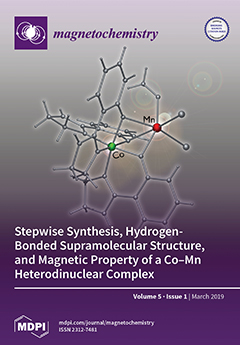By using [Ru
2(O
2CC
3H
7)
4Cl]
n (
1) as a starting material,
nBu
4N[Ru
2(O
2CC
3H
7)
4Cl
2] (
nBu
4N
+ = tetra(
n-butyl)ammonium cation) (
2) and [Ru
2(O
2CC
3H
7)
4(H
2O)
2]BF
4 (
3) were prepared. The lantern-type dinuclear structures with axial chloride ions or water molecules were confirmed for
2 and
3 by X-ray crystal structure analyses. The crystal structures of
2 and
3 were compared with that of
1. In the crystal of
2, there were three crystallographically different dinuclear units; the Ru–Ru distances of each unit were 2.3094(3), 2.3046(4), and 2.3034(4) Å, respectively, which were longer than those of
1 (2.281(4) Å) and
3 (2.2584 (7) Å). Temperature dependent magnetic susceptibility measurements were performed for
1 and
2 as well as
3. The effective magnetic moments (µ
eff) at 300 K were 3.97 (for
1), 4.00 (for
2), and 3.97 µ
B (for
3), respectively. The decreases in the µ
eff value were confirmed for all of the complexes due to the large zero-field splitting (
D):
D = 68 cm
−1 for
1, 78 cm
−1 for
2, and 60 cm
−1 for
3. Cyclic voltammograms measured in CH
2Cl
2 with a electrolyte of
nBu
4N(BF
4) showed the Ru
25+/Ru
24+ process at −0.2–−0.4 V (vs. SCE) and the Ru
26+/Ru
25+ one at 1.3–1.4 V (vs. SCE), of which potentials were confirmed by the DFT calculation for
nBu
4N[Ru
2(O
2CC
3H
7)
4Cl
2].
Full article





